There are few places were you can witness the immense power of the earth up close, but Geysir Hot Spring Area in Iceland is one of those places. Prepare to be awed by Iceland’s most active geyser and see one of the world’s most famous geysers in the world. This guide will introduce you to Geysir and give you all the details to plan a perfect visit.
In this Guide
Here’s what we’re covering in this post. We invite you to read the full guide or jump ahead to the section you’re most interested in.
- Vocab Lesson: Geysir vs Geyser
- What is Geysir Hot Spring Area
- Plan your Visit to Geysir
- Safety at Geysir
- Get Ready for your Visit to Geysir
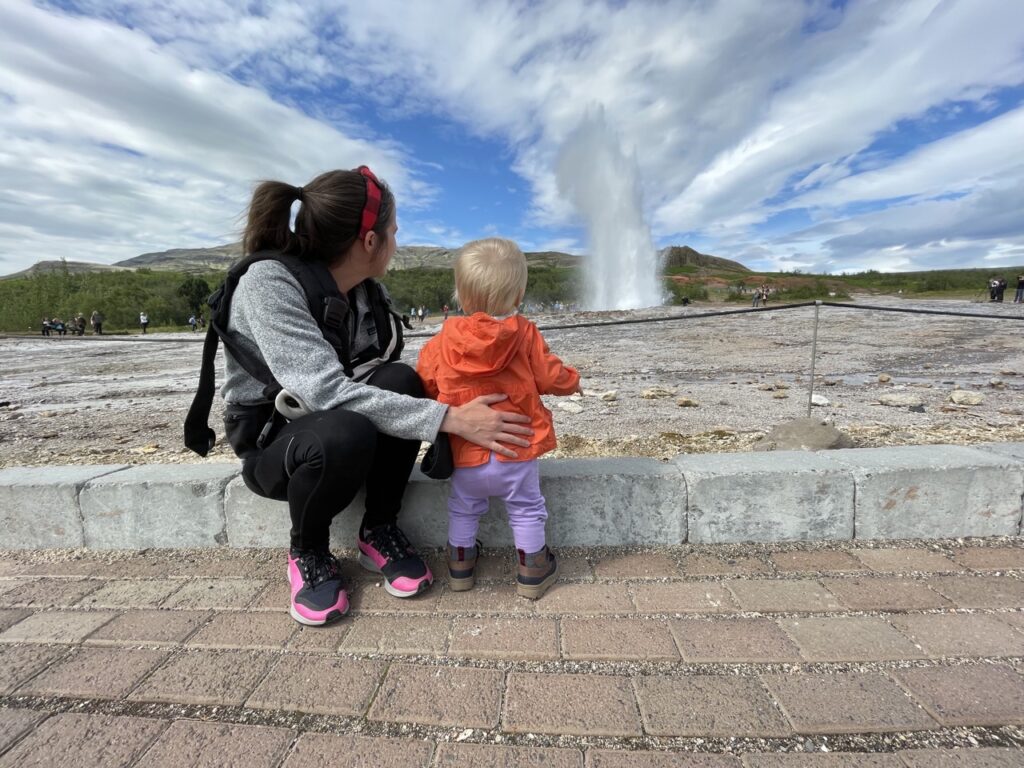
Geysir vs Geyser
Okay, time for a quick vocab lesson! I promise I have not been misspelling “geyser” as “geysir” so far in this post. Let’s take a quick dive into the etymology here.
- Geysir: Icelandic word meaning “the gusher”
- Great Geysir: The name given to a specific hot spring in Iceland that gushed water up from the ground – the first written account of this geological phenomenon
- Geyser: Generic English term for the geological phenomenon of a hot spring that gushes water up from the ground
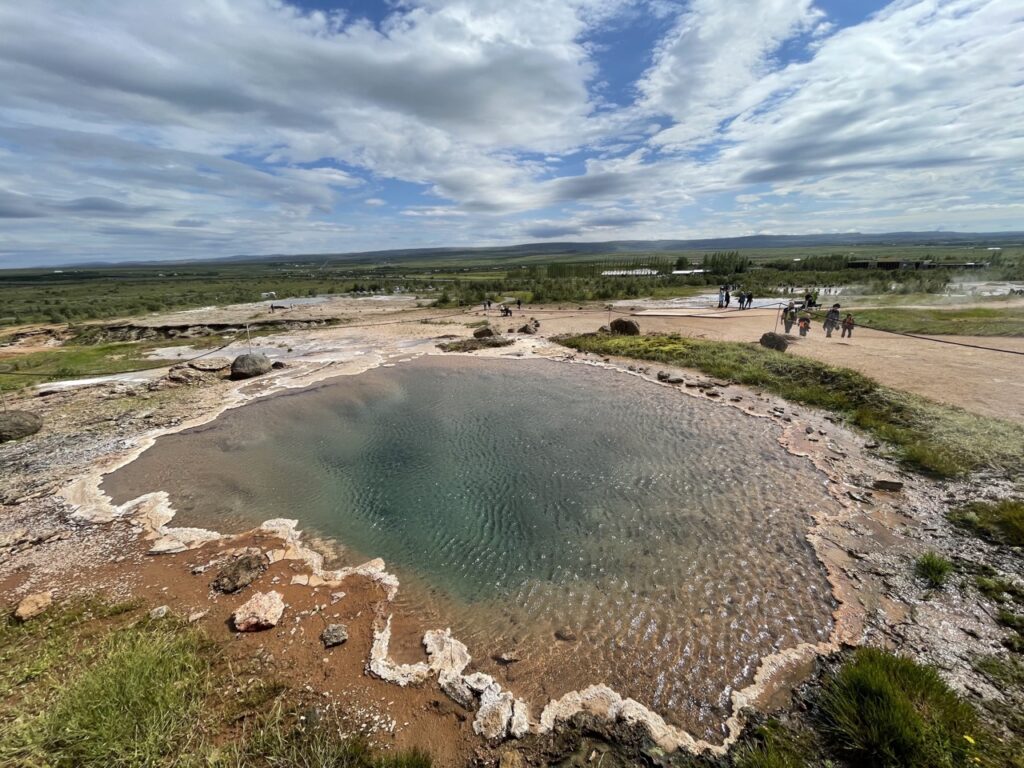
What you’ll commonly read is that the English word “geyser” is derived from the Icelandic word, “geysir,” meaning “to gush.” Sure, this is technically true, but it leaves out an interesting and important step in the middle.
The more accurate way to say this is that the English term “geyser” comes from the specific Icelandic hot spring named Great Geysir, which literally means “the gusher.”
The generic English term “geyser” wasn’t adopted because it meant “gushing.” The term was adopted from a specific gushing hot spring, Great Geysir, which the Icelandic people named after their own word for gushing (which actually came from the Old Norse word “geysa.”)
Am I the only one who thinks this difference matters? Cool, cool.
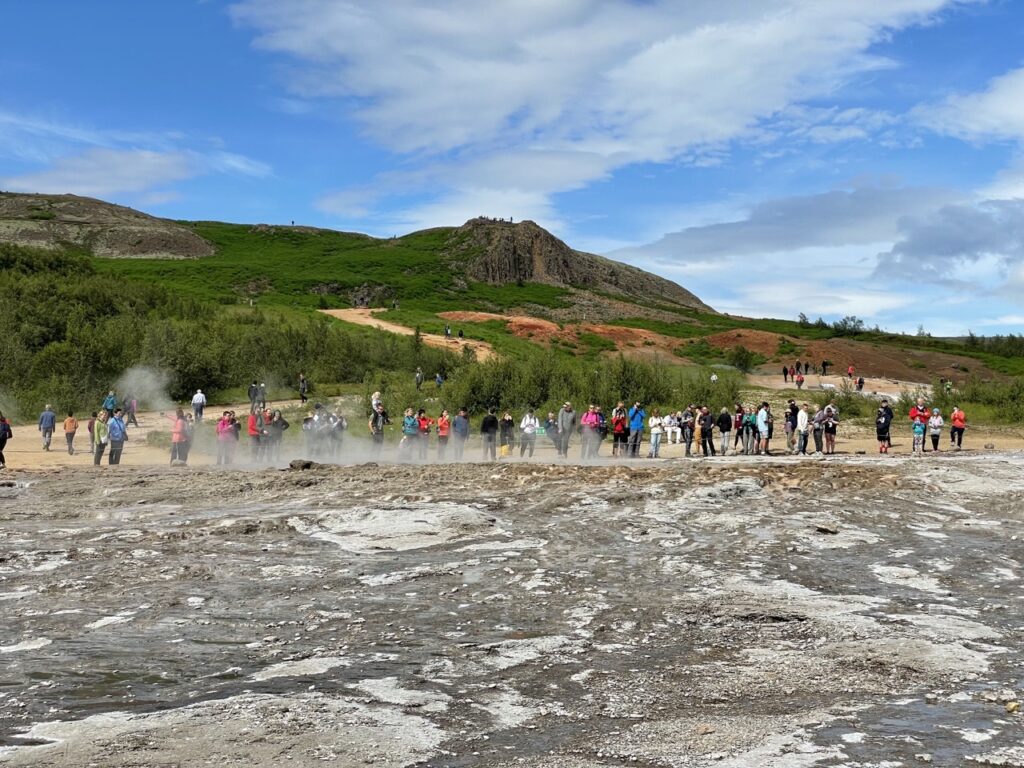
What’s actually important to note here is how I will use these terms in this post. As I’m an English speaker, I will use the term “geyser” when referring to the geological phenomenon. I will use the term “Geysir” as a shorter way to refer to the entire site of the Geysir Hot Spring Area.
What is Geysir Hot Spring Area
The Geysir Hot Spring Area (Geysir) refers to a geologically active area in southwest Iceland. There are 30ish hot pools and small geysers in the area, but the main draw is the two largest geysers: Strokkur and Great Geysir.
Great Geysir is the namesake and most famous geyser at Geysir. It’s the first geyser ever documented in written history and has historically reached heights of 500+ feet. Today, Geysir is mostly dormant and eruptions are years apart.
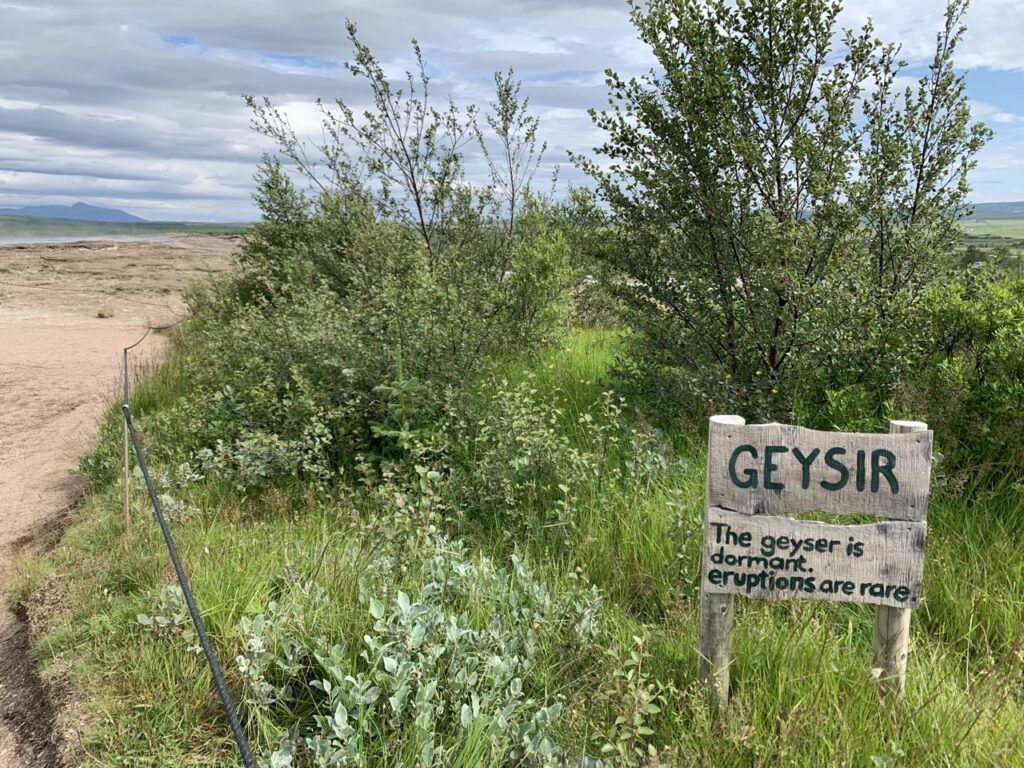
Strokkur is the most popular geyser at Geysir due to its frequent eruptions. Stokkur is the most active geyser in Iceland and erupts regularly, every 5-10 minutes, reaching heights of 50+ feet in the air.
In addition to the main geysers, there are several smaller hot springs and geysers in the area. You can see spouts of steam and streams of boiling hot water flowing throughout the area. The hot springs are visible from a protected brick pathway that cuts through the area and leads to the main geysers.
Plan your Visit to Geysir Hot Spring Area
Now that you’re clear on geysers and Geysir, let’s get to planning your visit. The nearby area has been built up for tourists, which makes it a really easy and pleasant stop. There is shopping, hotels, restaurants and more, all within walking distance from the main parking lot. Let’s dive in.
When to visit Geysir
Geysir Hot Spring area is open all year. When choosing your preferred season to visit, keep in mind that this attraction is all outdoors, meaning you will be exposed to the elements. As a reminder, Iceland has a temperate maritime climate, meaning it’s warm in the summer (May – October) and cold in the winter (November – April).
When choosing what season to visit, evaluate everything you want to do in Iceland during your trip. Other activities, like the Northern Lights (winter) or driving the full ring road (summer), will dictate your season more than Geysir will.
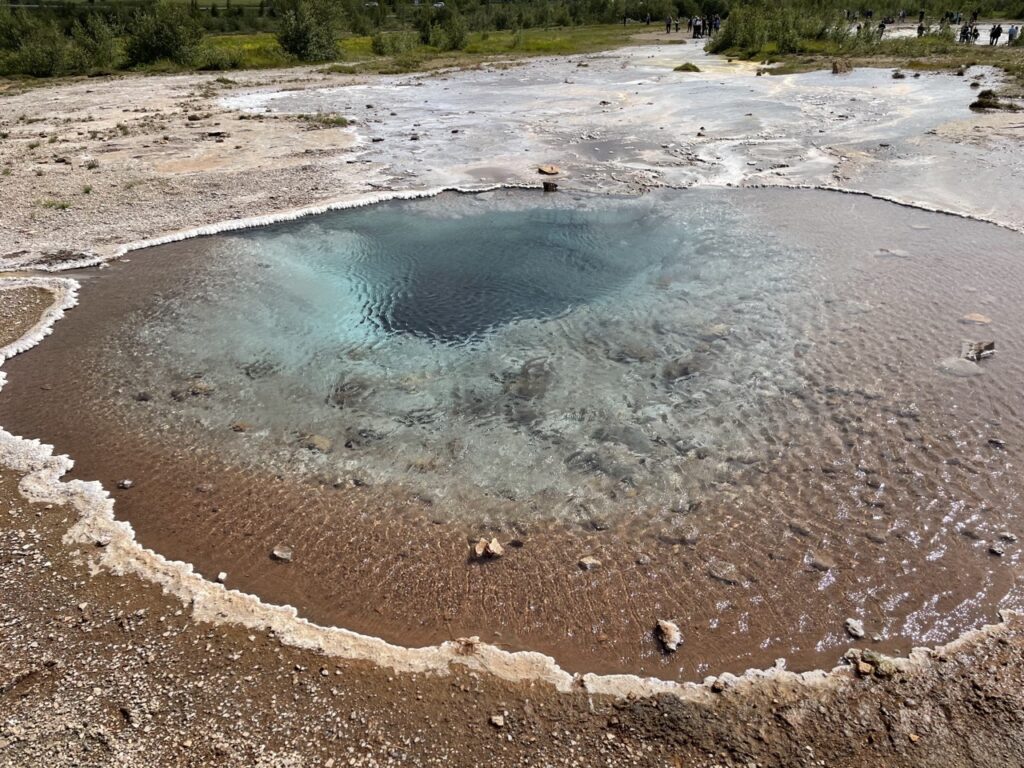
How to get to Geysir
Geysir Hot Spring Area is located about 65 miles east of Reykjavik.
It’s easy to get to via car, which takes about 90 minutes if you drive straight through. The route passes Thingvellir National Park at about halfway, which many people will choose to stop at.
There is free parking available at Geysir. The main, largest lot is located on the south/east side of Route 35. It takes about 6 minutes to walk from the parking lot toStrokkur, the active geyser.
Unfortunately you cannot get to Geysir Hot Spring Area by bus or public transit.
If you don’t want to or can’t rent a car to drive to Geysir, the other option is to visit with a tour group. Most of these tours will cover the full Golden Circle route and span a variety of activities and durations.
Amenities at Geysir
Across the street from the hot springs and adjacent to the main parking lot is a visitor center. There’s a gift shop, restaurants, and restrooms available. The amenities listed below are all available at the visitor center area.
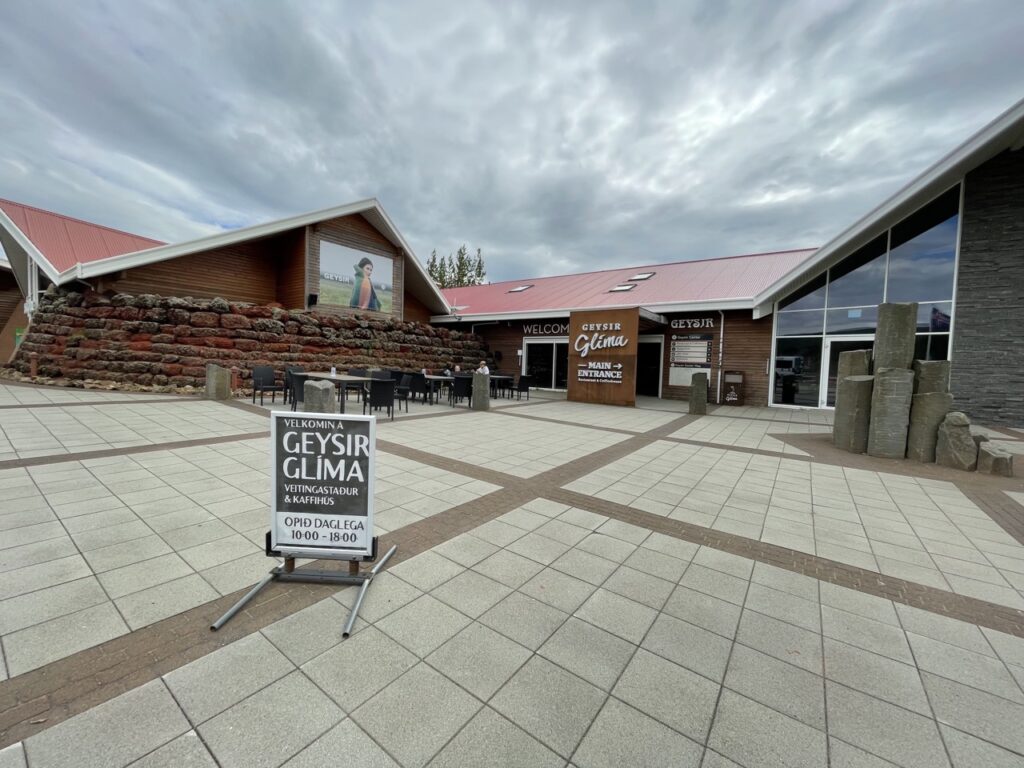
- Wifi: Yes, free wifi
- Bathrooms: Yes, bathrooms are available and free to use
- Souvenirs: Yes, lots. You can find everything from coffee mugs to traditional Icelandic sweaters for purchase in the gift shop.
- Parking: Yes, free parking
- Coffee: Yes, there is a coffee shop inside that serves coffee and hand-pulled espresso beverages.
- Food: Yes, a variety of food options, including vegetarian sandwiches, were available
- Dining Space: The tables for dining are located indoors. (Noting this due to the pandemic for people who may only want to dine outdoors.)
How much does it cost to visit Geysir
It is free to visit Geysir Hot Spring Area, including free parking.
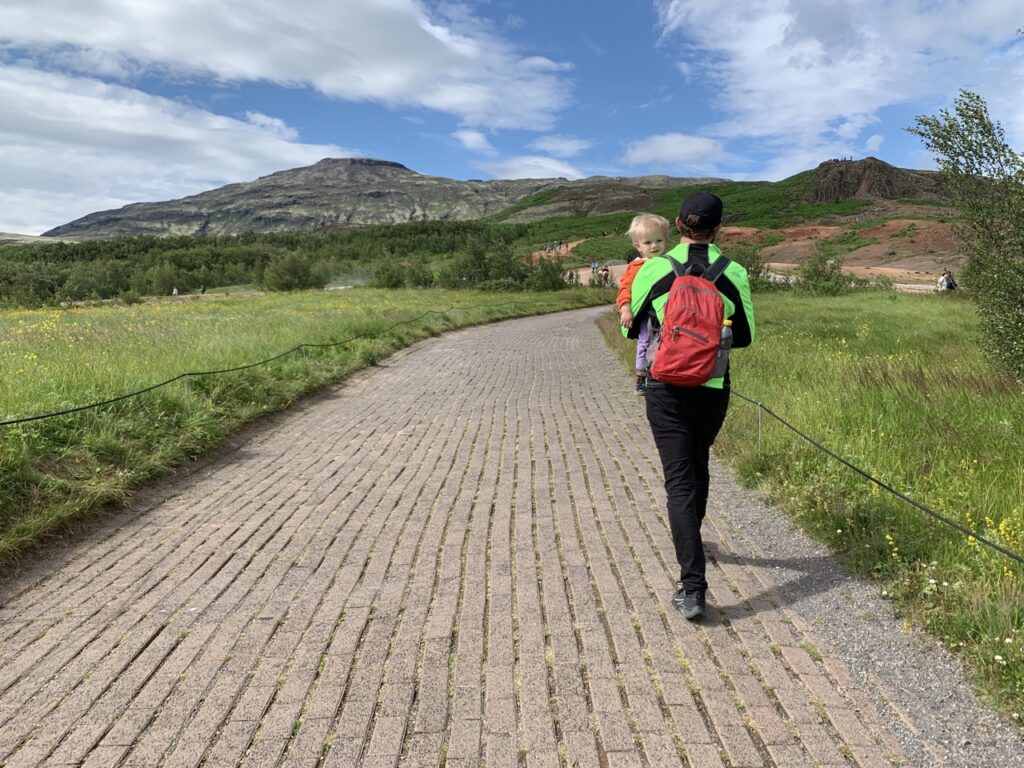
How Much Time to Spend at Geysir
We recommend spending 1.5 – 2 hours at Geysir Hot Spring Area. We’d break that up as one hour watching Strokkur geyser, 30 minutes exploring the rest of the hot springs and geysers, and then a flexible 30 minutes for amenities at the visitor center.
The active geyser, Strokkur, erupts every 5 – 10 minutes. We recommend staying for several eruptions, and changing your location between them for different views and angles. We think one hour watching the geyser is sufficient, though taking good photos may take longer.
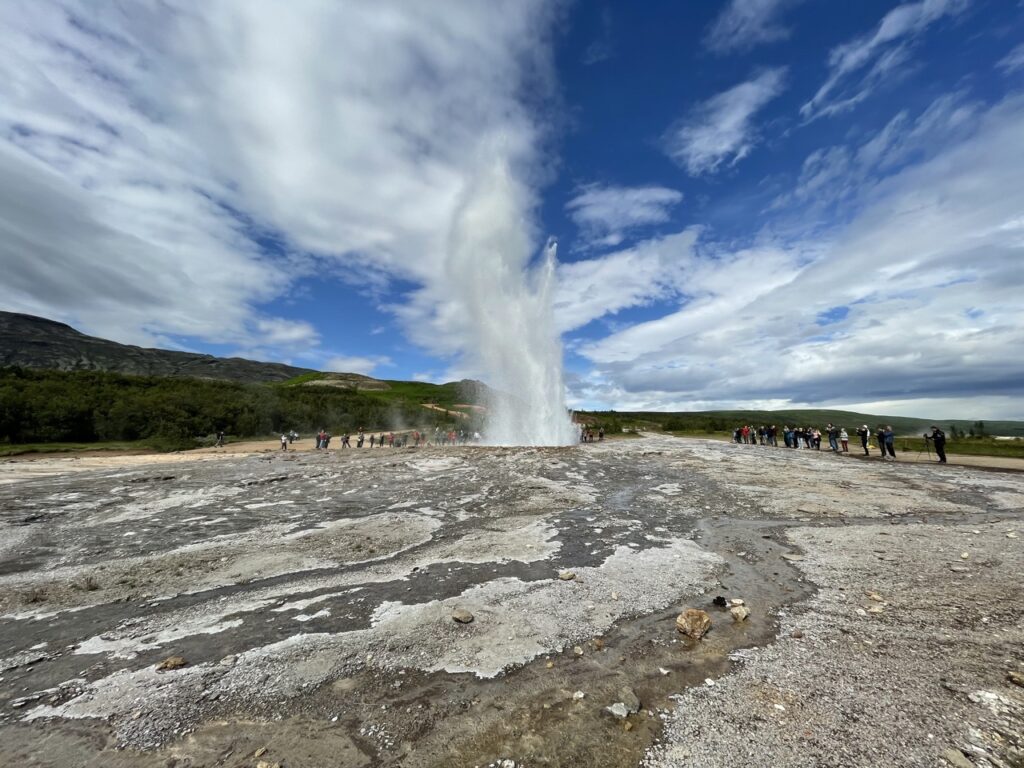
The walk from the parking lot to Strokkur goes through some of the hot springs and passes one of the smaller geysers. Then just past Strokkur, is Geysir. This famous geyser is mostly dormant, but is a pretty hot spring pool. There’s also a walking path to an elevated view of the geysers, which takes about 10 minutes.
All of these smaller attractions and walks will add up and likely take at least 30 minutes.
Lastly, you may want to plan a 30-minute buffer for a stop at the visitor center. The lines can get quite long for food during lunchtime, though. So if you want to eat there during busy times, it may take closer to an hour.
Geysir is actually a great spot to grab lunch if you’re doing the Golden Circle. Of the three main sights (Thingvellir, Geysir and Gullfoss), Geysir has the best food options in terms of quality, quantity of options and space to eat.

Where to stay at Geysir
There are places to stay at Geysir, but we recommend staying in Reykjavik. You will have far better choices and prices for accommodations in Reykjavik than in Geysir. Since it’s only a 90 minute drive, Geysir is an easy day trip from Reykjavik.
Geysir is also the second stop on the Golden Circle, which is the most popular tourist route in Iceland. Most visitors will move on from Geysir to their next stop, Gullfoss waterfall.
However, if you do want to stay in Geysir, you have some options.
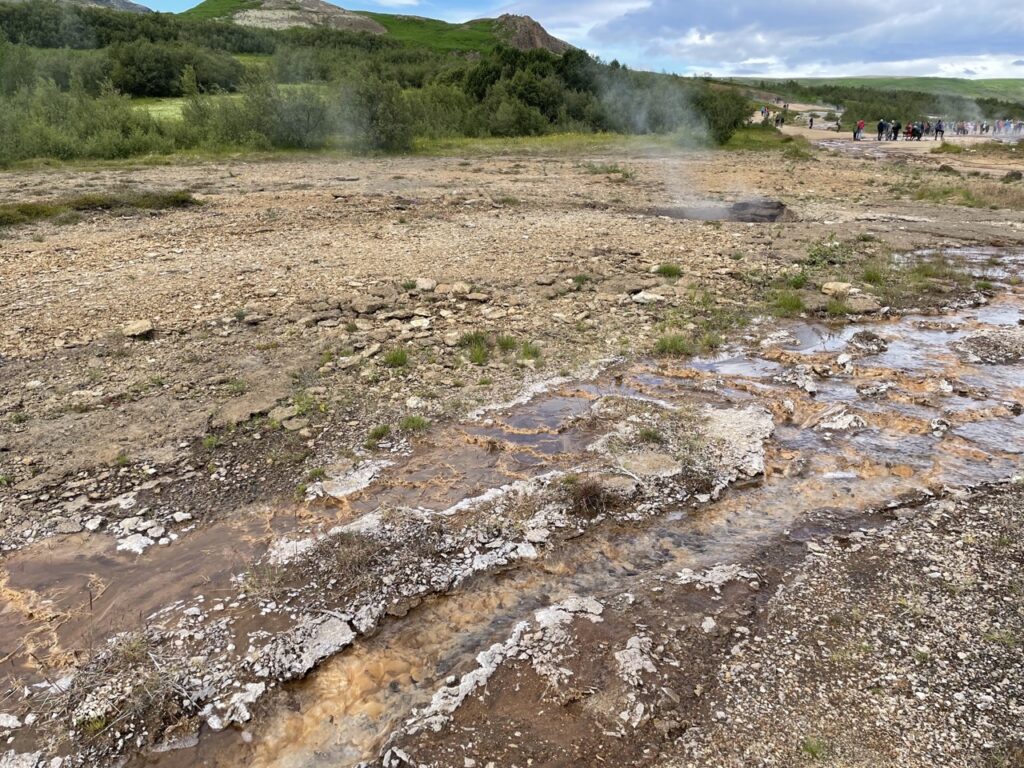
There are two hotels, Hotel Geysir and Litli Geysir Hotel, located across the street from the hot springs and adjacent to the visitor center. These hotels will cost between $150 and $250 USD per night, depending on when and how you book.
There is also a full-service campground across the street from the visitor center and just south of the hot springs. Tent camping and RV / van camping is allowed. Camping costs 1800 ISK ($14 USD) per night for adults and 500 ISK ($4 USD) for children 8-15. Children 7 and under are free. Reservations for camping are not required and you simply pay at the service house when you arrive.
Safety at Geysir Hot Spring Area
Geysers and hot springs are formed by geothermal activity. Magma under the earth’s crust heats rocks near the surface, which heat the groundwater. The hot water is forced up, and depending on the pressure and general underground structure, results in hot springs (pools of naturally hot water) or geysers (forceful bursts of water and steam from the ground).
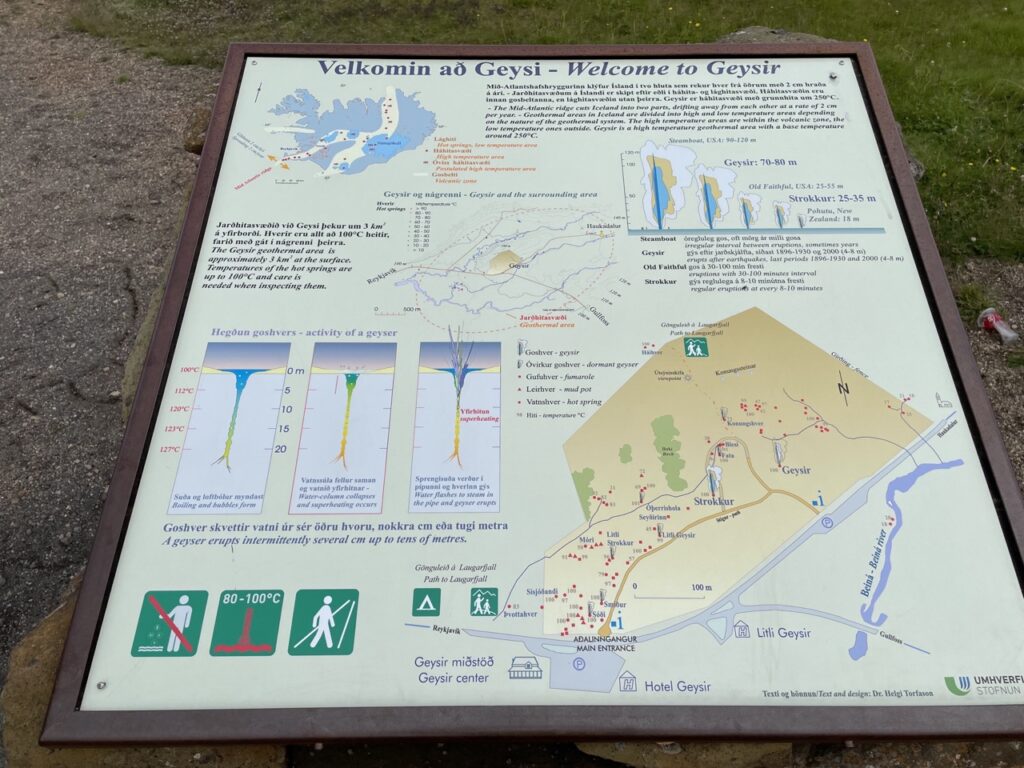
Some hot springs in Iceland are safe to swim in, but Geysir Hot Spring Area is not one of them. The water that bubbles above the ground and fills the hot springs at Geysir is extremely hot — 175°F – 215°F. It’s so hot that it would burn your hand immediately if you were to touch it. (And as a nearby sign will tell you, the nearest hospital is 62 km away which would make for a long, painful journey.)
Sidebar: I personally have had a carafe of 185°F (ish) coffee spilled on my foot, and let me tell you, it is absolutely awful. I’ve had a child, and I think that burn was more painful. Do. Not. Touch. The. Water.
I don’t say this to scare you, but to remind you to respect the nature at work here. Fortunately, the Geysir area is designed for tourists and is generally safe as long as you follow safety protocols.
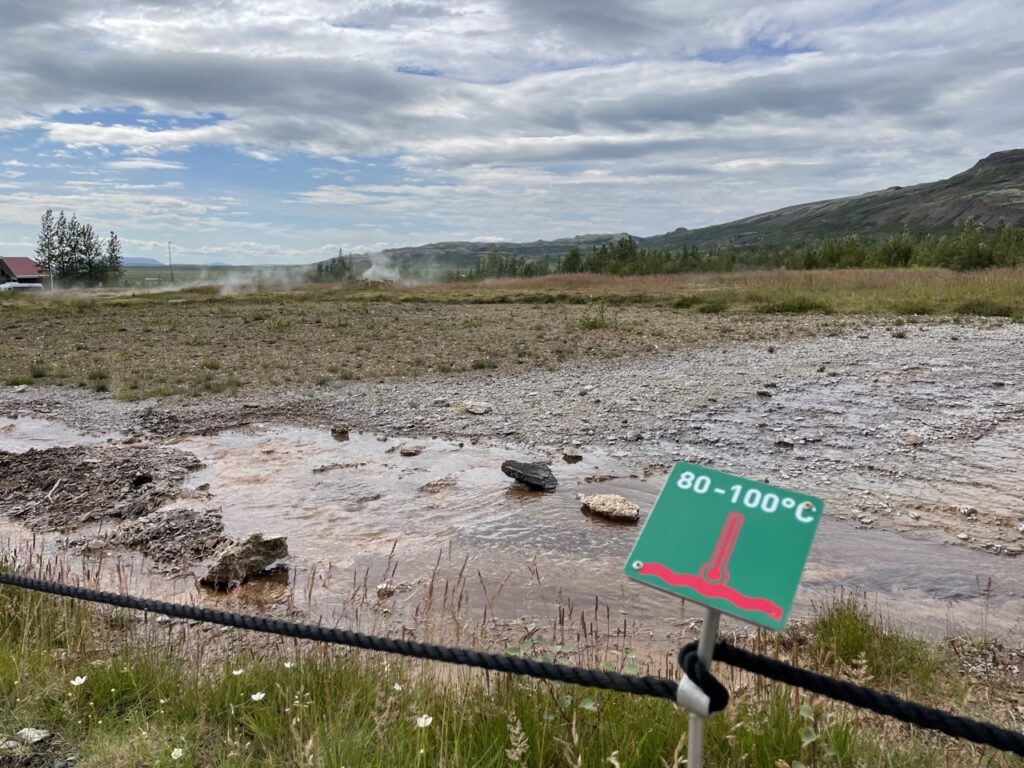
Safety Tips for Geysir Hot Spring Area
- Stay on the protected paths. The walking paths are clearly marked and roped off from the dangerous areas. Do not cross or reach over the ropes for any reason.
- Don’t touch the water. It’s so tempting to see the stream and want to check how hot it us. DON’T DO IT. It’s almost 200°F and will burn you immediately. You don’t have to confirm.
- Stay outside of the Strokkur splash zone. The area around the active geyser is roped off. This is to protect spectators from the geyser and the geyser from spectators. Do not cross the rope. You may still get wet outside the rope, depending on the wind and where you’re standing, but it will not burn you. The water actually cools extremely quickly after it’s expelled from the earth.
- Keep children close. As a parent of a fast and wobbly toddler, this is top of mind for me. The hot springs are roped off, but a child could slip under the rope in no time and that is terrifying. If you have a runner, be sure to hold them or keep them in a carrier while walking through the hot spring area. Near Stokkur, theres much more room to let them walk around safely.
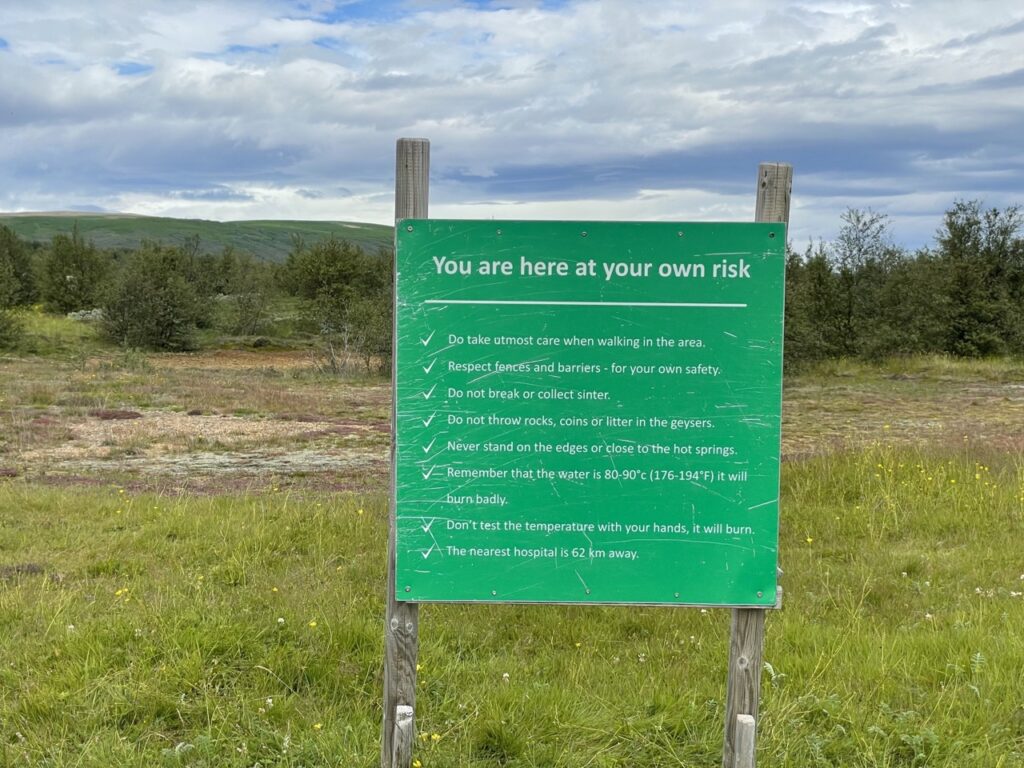
Get Ready for your Visit to Geysir Hot Spring Area
With the logistics out of the way, it’s time to get ready for your visit! Here are a few things to know before you go to Geysir.
Tips for Visiting Geysir
- Change up your view point. There is 360 viewing of Strokkur geyser. Consider making your way all the way around it, watching the geyser erupt from different angles and lightening.
- Turn on Live Photo. If you have an iPhone, be sure Live Photo is on. This will help to capture more of the eruption with each click of the camera. Then you can select the perfect frame later.
- Set a timer. Strokkur erupts every 5 – 10 minutes, but you never know when it’s coming. Set a timer for 5 minutes after the last eruption and then glue your eyes and camera to the geyser so you don’t miss it.
- Get a treat first. The visitor center sells ice cream, coffee and other snacks. Consider picking up one of these items and bringing it to Strokkur. Grab a seat on the side and enjoy your snack while casually watching the geyser erupt in the background. It’s so much better than drinking your coffee in the parking lot or eating in the cafeteria.
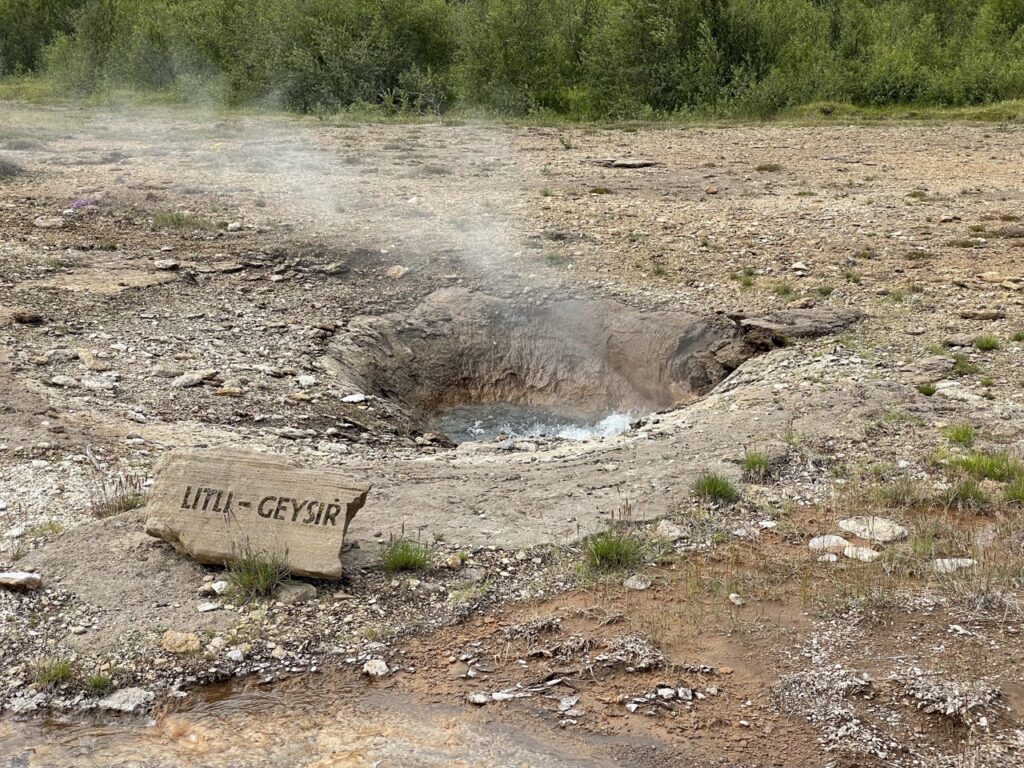
What to Wear to Geysir
Geysir Hot Spring Area is an outdoor activity. There is no protection from the sun or rain, so dress for the weather and elements. Generally speaking, since it’s a shorter stop, most people will not need any specific gear or extra attire to visit Geysir.
In the summer months, light layers are key. We recommend a long sleeve base layer with built in UPF, even if it’s warm. Then layer on a light jacket or fleece. If you only have room for one jacket, make sure you choose one that’s water resistant.
If you’re visiting in the winter, bundle up as temperature dictates. The paths can be slippery when covered in snow and ice, so boots or shoes with good traction are super important.
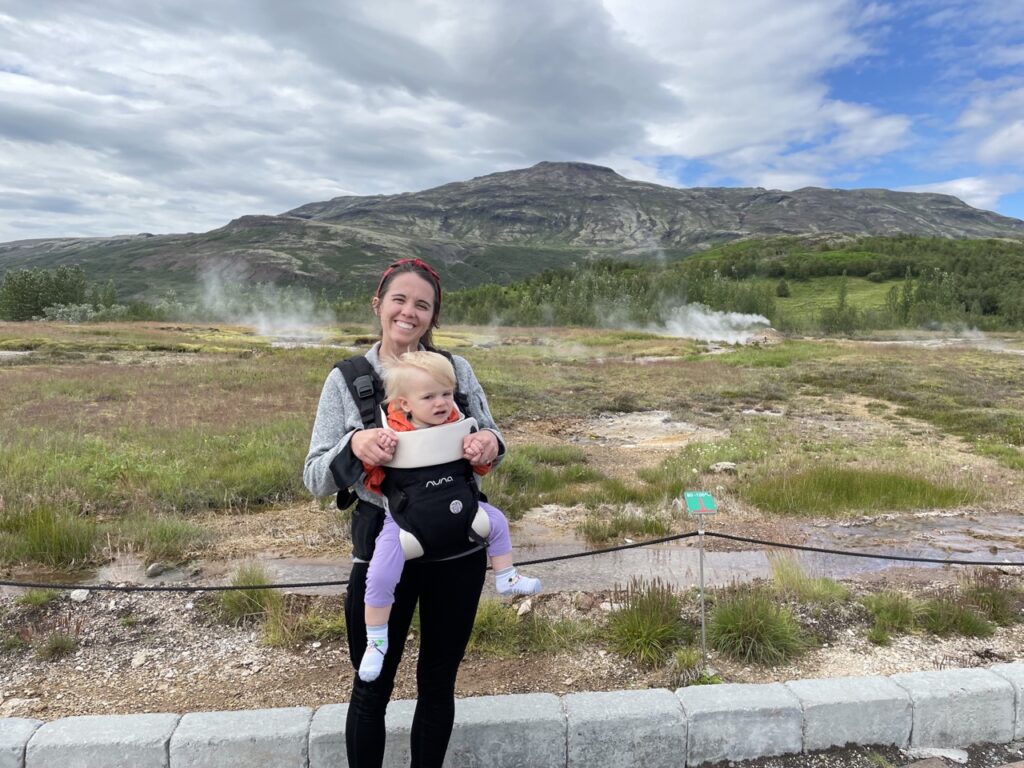
What to bring to Geysir
In additional to the clothes on your back, there are a few more things we recommend bringing with you. Also be sure to check our minimalist Iceland packing list to help get ready for your whole trip.
- Texting Gloves: If you’re visiting in the winter, definitely bring texting gloves! You will want to have your phone or camera out and ready for most of the time you’re at the geyser. These gloves will allow you to keep your hands warm and take photos at the same time.
- Baby Carrier: Parents of small children will want to pack a baby carrier. While some paths are brick, much of the area is rocky gravel and not idea for strollers. We used the Nuna CUDL carrier. We also have a separate post dedicated to baby wearing for travel, which includes lots of tips and reviews of our favorite baby carriers.
Conclusions
The Geysir Hot Spring Area is a great place to watch the immense forces of the nature at play. As someone who has never seen an active geyser before, I found this to be an incredible experience. If you’re visiting Iceland, you can’t miss a Golden Circle road trip with a stop at Geysir Hot Spring Area.
We hope you found this guide useful in planning to visit to Geysir. If there’s anything we missed, let us know in the comments! Whether you’re in Iceland now or planning your dream trip, we hope you have an amazing adventure.
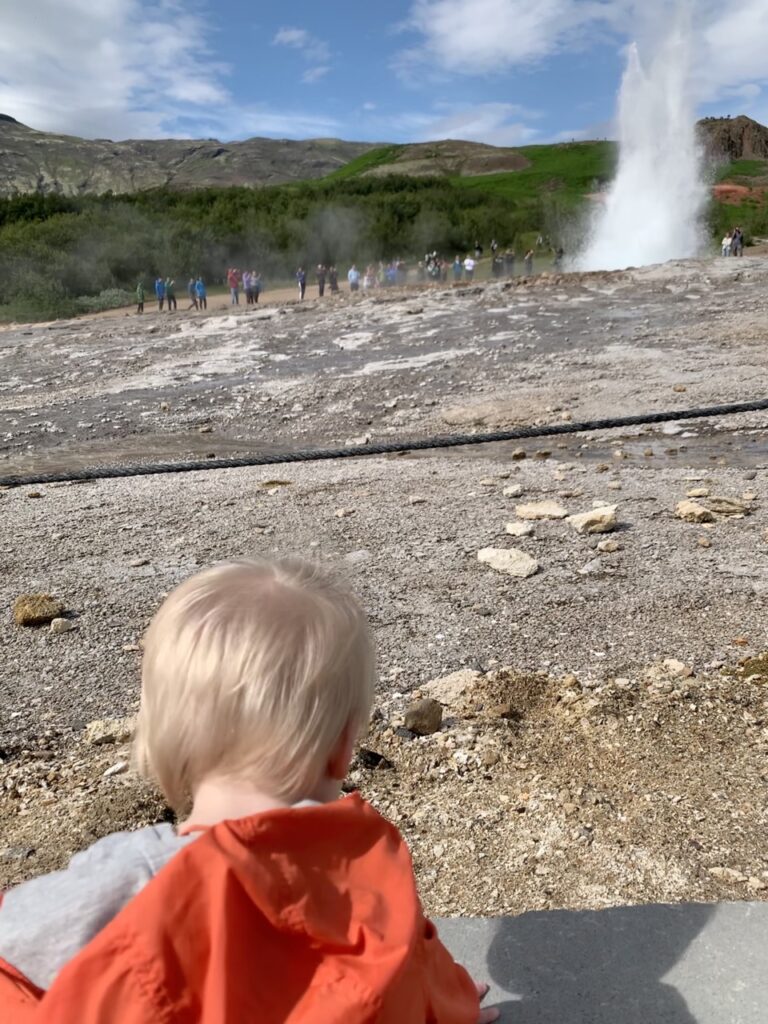
Our Full Iceland Itinerary
Planning a trip to Iceland? Here’s a look at our full itinerary for this trip…
- Minimalist Iceland Summer Packing List (That Fits in One Carry-On!)
- Detailed 3-Day Reykjavik Itinerary with Walking Routes
- Reykjavik City Guide – Everything to Know About Iceland’s Capital City
- Whale Watching in Reykjavík with Special Tours
- Planning Guide: Self-Drive the Golden Circle in Iceland
- Guide to Thingvellir National Park in Iceland
- Guide to Gullfoss Waterfall in Iceland
- Guide to Iceland’s Geysir Hot Spring Area
- A Perfect Visit to Seljalandsfoss Waterfall + Bonus Hidden Waterfall
- Planning Guide: Skogafoss Waterfall in Iceland
- Guide to Dyrhólaey Nature Reserve on Iceland’s Southern Coast
- Complete Guide to Vik, Iceland
- Guide to Reynisfjara Black Sand Beach in Iceland
- Guide to Jökulsárlón, Iceland’s Glacier Lagoon

Marine
Tuesday 26th of July 2022
Followed your blog step by step and had a fabulous day. Thanks!!!!
Emily
Wednesday 27th of July 2022
This makes me so happy! I'm so glad to hear it was helpful and you had a great day!
How to Plan a Family Summer Vacation to Iceland - Mommy Levy
Wednesday 27th of April 2022
[…] also known as hot springs, are Iceland’s major tourist attractions. The most famous and active geysers are located on the southern side of Iceland. The most active and visited geyser is Strokkur. […]